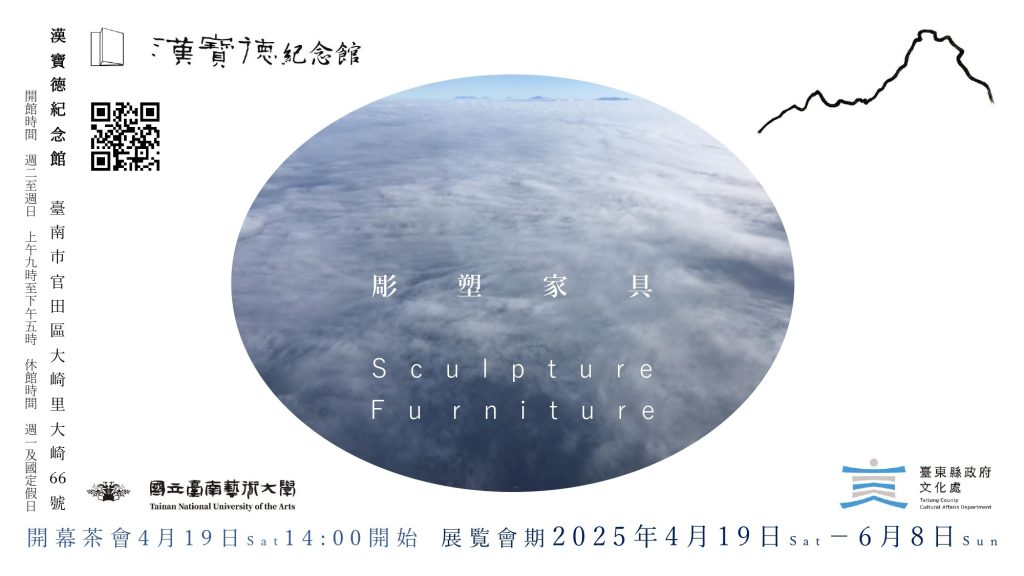▍展覽【雕塑家具−Sculpture Furniture】
策展人|菅野麻依子
本次展覽呈現的是一種從臺灣風土與日常生活中自然萌生的創造力,藉由作品傳達這份與土地共鳴的感受。
▍展覽資訊
展覽名稱|雕塑家具−Sculpture Furniture
展覽地點|國立臺南藝術大學 漢寶德紀念館(台南市官田區大崎里大崎66號)
展覽日期|114年4月19日(六)至6月8日(日)
開幕茶會|114年4月19日(六) 14:00
關於《雕塑家具−Sculpture Furniture》
家具作為實⽤的物件,還能是什麼?
展覽《雕塑家具−Sculpture Furniture》透過「家具」作為媒介,重新思考⾝體
與空間的關係。家具於此,亦作為體現建築與⾝體之間對話的交流載體,⾛進漢寶
德紀念館的觀眾,能在⾏⾛的過程感受⾃⾝所接收到⾮語⾔訊息,例如:視覺印象
、在場的位置、光影變化、聲⾳的回響、⾵與空氣的流動、以及空間結構的變化,
將這些迎⾯⽽來感官的交互經驗,納⼊對於雕塑家具的體認與理解。
本展將⽊⼯、⽊雕與⼯藝技法等,交融於建築空間中的視覺表現,作為⼀種思
考⽣存的起點。將前⼈孕育出的智慧,始終伴隨著我們的⾝體,持續延續與現實的
接觸點,更企圖與100年後、1000年後,或與100公⾥、1000公⾥外某個⼈的⾝體
產⽣連結,是⼀場超越語⾔、時空的藝術表現,以實際感官交流的實驗,同時提出
「⼈該如何活在當下?」這⼀根源性的問題。
此外,以⽊材為⾸的⾃然材質,與⼈體接觸時能帶來溫度與舒適的感受,因此
許多家具與室內⽤品皆以⽊質製作。當今資訊社會急遽發展,我們的⽣活越來越數
位化,⾝體依舊存在於真實的物理世界之中,即使我們⾝處於虛擬空間中進⾏⼯作
,實際觸碰的依然是⽊製桌椅、⽊地板、天花板與牆⾯、甚⾄是天然纖維或⼿⼯製
成的布料等,這些具體可觸的「現實」。
所謂的「雕塑家具」,正是在臺灣⾵⼟⺠情中誕⽣的⼀種超越⽂化與時間空間
的藩籬,透過⾝體原初感官⽽展開的溝通⽅式,在多元⽂化共存的臺灣,不同⽂化
背景的藝術家於此⽣活與創作,在⾃然地理環境中形塑出富有創造⼒的⽣活空間。《雕塑家具》在這樣的背景下誕⽣,本次邀請了六國的藝術家,擴展以⾝體感知為
經,⽊質創作為緯,交織出⾃然流露的創作表現。
展出藝術家:※ (依英⽂姓⽒字⺟順序排列)
安聖惠 An Sheng Hui(臺灣)
張家駒 Chang Chia Chu(臺灣)
張志前 Chang Chih Chien(臺灣)
簡吟如 Chien Yin Ru(臺灣)
邱品芸 Chiu Pin Yun(臺灣)
周靜怡 Chou Ching Yi(臺灣)
安君實 Pasulange Druluan(臺灣)
達鳳・旮赫地 Tafong KaJ(臺灣)
哈拿・葛琉 Hana Keliw(臺灣)
郭素如 Kuo Suru (Angel)(臺灣)
郭宗暉 Louis Kwok(新加坡)
李焞曜 Lee Chun Yao(臺灣)
林鴻易 Lin Hong Yi(臺灣)
陸明思 Christopher Loomis(美國)
⽶類・瑪法琉 Milay Mavaliw(臺灣)
伊命・瑪法琉 Yiming Mavaliw(臺灣)
歐⾈ Euroba Ou(尼泊爾藏區)
潘容鈞 Pan Jung Chun(臺灣)
拉黑⼦・達⽴夫 Rahic Talif(臺灣)
饒愛琴 Rao Aichin(臺灣)
希巨・蘇⾶ Siki Sufin(臺灣)
菅野⿇依⼦ Maiko Sugano(⽇本)
巴魯(Balu) Alvaro Trugeda(⻄班⽛)
⾺浪・烏⽡⽇ Ma Lang Wu Wa Rih(臺灣)
蘭調織⼥ A’tolan Weavers Women’s Studio(臺灣)
——————————————————
關於策展⼈
菅野⿇依⼦ Maiko Sugano
⽇籍藝術家(1974年⽣於東京)東京藝術⼤學博⼠,擁有德國、美國等旅居經驗。創作擅⻑處理天然媒材的紋理與質感,並巧妙與地景、空間結合,呈現對⼤地的敬意
和頌讚,作品引領觀者感受源於⾃然的純樸與野性。曾榮獲東京第六屆帕爾科城市
藝術優秀獎,(2006年)進⼊國⽴東京藝術⼤學,成為先端藝術表現科助理研究員,
(2009年)於德國⿇塔赫爾福德博物館駐點創作,專研藝術、環境與⼈的關係。曾兩度
受邀來台參與東海岸⼤地藝術節,創作〈歸〉、〈⾵〉、〈聯〉⽊作裝置藝術作品
廣獲好評。現在在臺東成⽴⽊⼯房,持續進⾏藝術創作與交流。
(英文)
“Sculpture Furniture” Exhibi3on Introduc3on
The exhibi(on Sculpture Furniture invites viewers to rethink furniture not just as objects, but as
a medium through which we explore the rela(onship between body, space, experience, and
func(onality. Twenty-five ar(sts from six countries use the idea of furniture as a
communica(ve medium, reflec(ng the ongoing dialogue between architecture and the human
body.
Upon entering the Han Pao-Teh Memorial Museum, visitors are immersed in a symphony of
non-verbal messages: visual impressions, bodily presence within the space, shiHing paIerns of
light and shadow, echoes of sound, the movement of air, and evolving spa(al structures. These
interac(ve sensory experiences become an integral part of the viewer’s encounter with
sculpture furniture.
This exhibi(on integrates woodworking, wood carving, and craH techniques into the visual
language of architectural space, serving as a star(ng point for reflec(ons on existence itself. It
seeks to link the wisdom passed down by our predecessors—wisdom that has always
accompanied the human body and shaped our engagement with reality—with the bodies of
people a hundred or even a thousand years into the future, or across distances of a hundred or
a thousand kilometers. It is an ar(s(c expression that transcends language and (me, an
experiment in sensory communica(on, while simultaneously posing a fundamental ques(on:
How should we live in the present moment?
In today’s rapidly developing informa(on society, our lives are increasingly digital. Yet our
bodies con(nue to exist in the tangible physical world. Even as we work within virtual spaces,
what we physically touch are wooden desks and chairs, wooden floors, ceilings, and walls, as
well as tex(les craHed from natural or handmade fibers—these enduring reali(es.
Sculpture Furniture is a form of communica(on rooted in the local customs and prac(ces of
Taiwan, transcending cultural, temporal, and spa(al boundaries through the primal senses of
the body. In Taiwan—a land where mul(ple cultures coexist—ar(sts from diverse backgrounds
live and create, shaping a vibrant crea(ve space within its natural environment. It is within this
context that Sculpture Furniture was born.For this exhibi(on, ar(sts from six countries have been invited, weaving a naturally emerging
crea(ve expression where bodily percep(on forms the warp and woodworking and craH
prac(ces form the weH.
April 2025
Curator, Maiko Sugano

